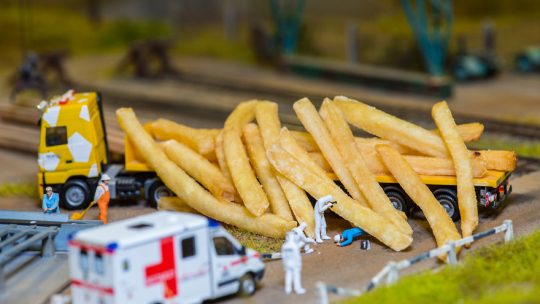
It is undeniable that the roots of NASCAR can be traced back to the days of prohibition in the U.S. While many believe this is an urban legend, it is, in fact, true.
In the early days of prohibition, “moonshine runners” (illegal whiskey delivery boys) would drive like maniacs to give the slip to federal officers. These drivers quickly gained a reputation for outrunning the police.
No one knows exactly when the drivers started competing against each other, but soon everybody was talking about the moonshine runners. In 1948, one of the drivers, Bill France (Big Bill), gathered everyone together – drivers, car owners and mechanics – to form the National Association for Stock Car Auto Racing (NASCAR) and the rest is history. (Source 1 | Source 2 | Photo)

Yes, we are talking about the bubbly, fizzy orange drink manufactured by Coca-Cola that is very popular in Europe, parts of Asia, Africa and Latin America, but did you know that the origins of this beverage could be traced back to Nazi Germany?
The events of December 7, 1941 – Pearl Harbor – brought WWII to U.S. shores. However, Pearl Harbor also played a vital role for Coca-Cola in a slightly different way.
After the attack on American soil, Coca-Cola stopped shipping its intimately guarded secret syrup to Germany. This meant Max Keith, the chief of Coca-Cola in Germany, was no longer able to produce the world’s favorite fizzy beverage and stocks were quickly depleting.
Max, determined to keep Germany awash in soda, brought together some random ingredients including some leftover by-products from a local cheese factory, remains of apple after being processed for cider and a mountain of artificial sugar. The result was Fanta, a drink that quickly caught on all over Nazi Germany not only because it was quite tasty, but also because it made an excellent substitute for soup broth.
When the war ended, Fanta production was stopped then re-introduced, (with slight improvements) to compete with Pepsi. (Source | Photo)

Ever wondered how the world’s favorite drink got its name? Coke’s super secret formula may have something to do with it.
Coke’s original formula had two main ingredients that gave the beverage its distinct flavor – coca leaves and cola nut. Yes, we are talking about the same coca leaves that are used in cocaine. Coke did contain a small amount of cocaine (or fluid extract of coca leaf).
Back in the day, cocaine was widely used as a medication and the soft drink was developed to be a tonic for nerves. When the draconian effects of cocaine were finally discovered, Coke altered its formula to use processed Coca leaves (after extracting the drug) which it uses to this day.
Coca-Cola’s history is a lot murkier than this, but that could be the topic of a whole new list. (Source 1 | Source 2 | Source 3)

Avedis Zildjian is one of the most recognizable brands in the world of music. You would be hard pressed to find any percussionist who doesn’t swear by Zildjian cymbals, however only a handful know that these popular instruments of music were once popular instruments of war.
Zildjian cymbals have a history that dates back to a 17th Century Armenian alchemist named Avedis. In a bid to turn bronze to gold, Avedis figured out a way to combine silver,copper and tin with bronze in a way that allowed the alloy to be beaten into incredibly thin discs. These discs produced an incredibly high pitch sound when struck and were also lightweight and easy to carry. Avedis knew that the emperor’s army could use the discs as a weapon of intimidation.
Avedis took his invention to the ruler of the Ottoman Empire, Sultan Osman II, and became a Zildjian (Armenian for cymbal-maker).
Centuries later, Avedis’ descendants continue to use the secretly guarded ancient technique to make the famous cymbals which are known for their sustain, power and clarity of sound. (Source 1 | Source 2 | Photo)

During the early 1900s, one of the greatest taboos was masturbation. People firmly believed that the practice would lead to mental and physical health problems, thanks to the hard work of a handful of anti-masturbation crusaders.
John Kellogg was a trained physician and nutritionist who attempted to deter masturbating youth with techniques such as sewing the male foreskin with a silver wire and burning the female clitoris with carbolic acid.
Kellogg believed meat created sexual urges and insisted that people should consume more cereal and nuts to curb their masturbation. He created Kellogg’s Corn Flakes with his brother Will, who worked as a bookkeeper at the sanatorium where John practiced.
Will was not interested in marketing corn flakes as an anti-masturbation supplement and instead sold the sugar-coated flakes as a breakfast alternative.(Source 1 | Source 2 | Source 3 | Photo)

Graham crackers were a part of an essential diet designed by Sylvester Graham to help people control their sexual urges.
Much like John Kellogg, Sylvester Graham pushed a cereal/nut based diet and asked people to not consume meat.
The original recipe for graham crackers called for bland biscuits made out of unrefined flour, but the crackers have undergone many changes over the years and the present version has very few similarities to its original ancestor. (Source)

The history of sanitary napkin manufacturer Kotex dates all the way back to World War I.
In 1914, paper supplier Kimberly-Clark developed a unique product processed from wood known as “cellucotton.” The material had over 5 times the absorbing capacity of cotton and was half the price. Cellucotton was used by the U.S. military during World War I to stop wounded soldiers from bleeding to death.
After the war, Kimberly-Clark decided to
re-purpose Cellucotton to create disposable sanitary napkins. This was groundbreaking at a time when only cotton rags were being used by women for their sanitary needs.
Cellucotton transformed itself into Cellunap and eventually Kotex (Cotton-Textile) thanks to some clever marketing efforts by the Charles F.W. Nichols Company. By 1945, every American woman was using sanitary pads. (Source | Photo)

When it was established in the mid-1850s, Hollywood was once on the outskirts of Los Angeles. The land and weather were conducive to agriculture all year round. Hollywood was a thriving community of farmers until the early 1900s when moviemakers were attracted to the area for the same reasons. When the first film studio, the Nestor Company, set up shop in 1911 others followed suit and the rest, as they say, is history.(Source)

Admit it, most of you have at least one can of Red Bull stashed away somewhere in your home. Did you know that the world’s favorite energy drink has some skeletons in its closet?
No, we are not talking about the urban legend that suggests Red Bull has bull sperm. What it does have is an amino acid most commonly found in cow bile.
Dietrich Mateschitz (the guy who created Red Bull) came across a rejuvenating tonic sold in Thailand that went by the name “Krating Daeng” (Red Water Buffalo). Mateschitz found that the tonic worked incredibly well in curing his jetlag and he was immediately struck with an idea.
Mateschitz rebranded the syrup for the western market after tinkering with the original recipe. The main components of Red Bull are taurine (the stuff that gives you the wings), caffeine and loads of artificial sugar.
Taurine (Greek for bull urine) is a product that is found most abundantly in cow bile. It is present naturally in most mammals and trace amounts of taurine can also be found in meat and diary products. Studies suggest that it is safe for consumption in small quantities.
The taurine in Red Bull is the source of all the controversies associated with the drink (including the one about bull sperm). Sadly for conspiracy theorists, Red Bull synthesizes taurine in laboratory and not from bovine urine as many may lead you to believe.(Source)

Lululemon is the latest entry into the list of famous companies with bizarre origins. CEO Chip Wilson wrote a blog about how birth control and changes in the lifestyle of women over the past few decades eventually gave way to the creation of lululemon.
In his blog, Wilson talks about how divorce and the hunt for equality led women to give up important aspects of life such as exercise, sleep and a social life. He goes on to say that this power hungry lifestyle led women to smoke and develop a taste for martinis. In turn, smoking and excessive usage of birth control led to more women developing breast cancer. According to Chip,
“lululemon was formed because female education levels, breast cancer, yoga/athletics and the desire to dress feminine came together all at one time.”
Not sure if it qualifies for a bizarre origin, but Chip Wilson sure does know how to whip up a controversy. After all, it did get lululemon into the limelight, even if it was for all the wrong reasons. (Source)
Source: Oddee.com
This post has already been read 3513 times!















